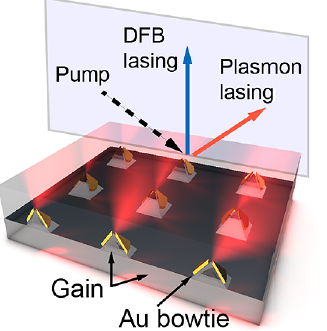Researchers create laser the size of a virus particle
November 7, 2012

Array of plasmonic lasers (credit: Jae Yong Suh et al./NANO Letters)
A Northwestern University research team has found a way to manufacture single laser devices that are the size of the HIV virus (about 150 nm.) and operate at room temperature.
These plasmonic nanolasers could be readily integrated into silicon-based photonic devices, all-optical circuits, and nanoscale biosensors.
Reducing the size of photonic (such as lasers) and electronic elements is critical for ultra-fast data processing and ultra-dense information storage.
Coherent light sources (lasers) at the nanometer scale are “important for exploring phenomena in small dimensions and for realizing optical devices with sizes that can beat the diffraction limit [lowest resolution achievable] of light,” said professor of materials science and engineering Teri Odom, who led the research.
The diffraction limit is one half of the wavelength of light, so for red light (a wavelength of about 700 nm.), for example, that would be about 350 nm. — about 16 times larger than the smallest feature (22 nm.) in the current generation of Intel chips — too large to work with ultra-small devices.
“The reason we can fabricate nano-lasers with sizes smaller than that allowed by diffraction is because we made the lasing cavity out of gold (Au) nanoparticle dimers — structures with a 3-D ‘bowtie’ shape,” Odom said. These metal nanostructures support localized surface plasmons — collective oscillations of electrons, avoiding the diffraction limit with light.
“The lasing region within the plasmon bowtie is around 30 nm.,” Odom explained to KurzweilAI in an email. This compares to the smallest dimension of visible light (violet light): about 380 nm., a diffraction limit of 190 nm.
The use of the bowtie geometry has two significant benefits over previous work on plasmon lasers: the bowtie structure provides a well-defined, electromagnetic hot spot in a nano-sized volume and the individual structure has only minimal “losses” (lower output) because of its discrete geometry.
“Surprisingly, we also found that when arranged in an array, the 3-D bowtie resonators could emit light at specific angles according to the lattice parameters,” Odom said.
UPDATE Nov. 7, 2012 — corrections, based on clarifications to the Northwestern University statement provided to KurzweilAI by Dr. Odom:
- The “virus size” refers to the HIV virus (about 150 nm.), not the smallest virus (about 20 nm.).
- The “no fundamental size limits” was in reference to the lower bound of the diffraction limit of light (190 nm. for violet). The lasing region within the plasmon bowtie is around 30 nm., which defines the practical lower bound of the laser wavelength.